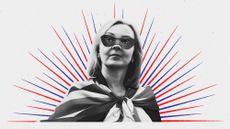How did humans learn to paint in 3 dimensions?
For centuries, art was weirdly flat and unrealistic. And then all of a sudden...


If you begin clicking through The Portrait Project's timeline, a strange thing starts to happen around the 1300s. The flat, childish depictions of kings and saints begin to change. Their faces start to curve, ever so slightly, into what looks like a third dimension. Noses begin to have shading and depth. The Christ child begins to look like he's being held by his mother, not sitting flush with her. The portraits are still flat and unnatural, but not nearly as primitive as the portraiture that came before them.
Then come the 1400s, and suddenly portraits become people. They pop off the canvas in variations of darkness and light; their faces detailed and proportioned.
I was puzzled by this. Being able to paint in three dimensions is not like being able to build a car. For a car to work, you must learn thousands of separate skills and concepts, from how to make steel to how to drill for oil, and then piece them precisely together. Those processes took thousands of years to culminate in Karl Benz's Motorwagen and Henry Ford's Model T.
Subscribe to The Week
Escape your echo chamber. Get the facts behind the news, plus analysis from multiple perspectives.

Sign up for The Week's Free Newsletters
From our morning news briefing to a weekly Good News Newsletter, get the best of The Week delivered directly to your inbox.
From our morning news briefing to a weekly Good News Newsletter, get the best of The Week delivered directly to your inbox.
But to paint photo-realistically, that's different. It seems like a simple matter of sweeping your paint brush a different direction, of using darker paint for shadow and making things smaller if they're far away. How could the artists of the first millennia and before not know how to do this? It's as if the knowledge hung there in the air, unseen or ignored.
Or did it?
**
James G Harper is a professor at the University of Oregon who specializes in the history of Renaissance art. According to Harper, the first misconception is that humans never knew how to draw in 3D before the 1300s. He points to the work of ancient Romans in the Pompeian Second Style wall paintings and the 8th century illuminated manuscripts, the Coronation Gospels of Charlemagne, which, although primitive, show clear use of realism and perspective.
Sign up for Today's Best Articles in your inbox
A free daily email with the biggest news stories of the day – and the best features from TheWeek.com
The real reason that three-dimensional art was seldom seen before the 14th century was that artists didn't want to portray life in three dimensions. Harper explains: "In the medieval period artists lost the desire to make lifelike images. The job of art was not to reproduce the real world, but instead to show another world. Unshackled from the mundane task of realism it entered a more expressive realm."
Western Civilization after the fall of the Roman Empire was miserable, riddled with plague and hunger and oppression. People of the Dark Ages were simply waiting out their time on this mucky rock called Earth until they could be called to Heaven. And it was the surreal unknown of Heaven that most strongly influenced their work.
Gradually, artists lost the knowledge required to render realistic imagery. Says Harper: "Bit by bit, (artistic) training stopped including things like perspectival composition or the modeling of 3D forms through the modulation of light and shadow. To regain that, one would have to retrain oneself."
That retraining was sparked by the Renaissance. Renaissance means rebirth, a finding value in the old ways. The ancient world was re-examined and revived; one facet being the desire to paint realistically. Simultaneously, as the works of the great ancient philosophers were being widely read, the individual self became interesting again. The human form and the life within it became worthy of close examination and accurate reproduction.
A 13th century painter named Giotto was on the forefront of this revolution. As one 17th century biographer said, Giotto initiated "the great art of painting as we know it today, introducing the technique of drawing accurately from life." He laid the groundwork of realistic painting that has touched every artist from Michelangelo to Thomas Kinkade.
The mathematical precision that later artists would use to bring proportion to their canvases was slower to develop. Says Harper: "For modeling with light and shadow (as well as psychological realism) Giotto is a great artist to consider. But mathematical perspective was truly lost, and though Giotto understood that diagonal lines signaled spatial depth, it was not until Brunelleschi's c. 1410 experiment that they understood it systematically."
There isn't a single reason Western Civilization suddenly gained (or regained) the ability to paint in three dimensions. It came about through the retrieval of old ideas and the birth of brand new ones. People began to see life as more than just God's desperately uncomfortable waiting room. Artists began to observe the essence and detail that filled their actual lives, and, as artists must, brought what they saw into the light.
Create an account with the same email registered to your subscription to unlock access.
Therese O'Neill lives in Oregon and writes for The Atlantic, Mental Floss, Jezebel, and more. She is the author of New York Times bestseller Unmentionable: The Victorian Ladies Guide to Sex, Marriage and Manners. Meet her at writerthereseoneill.com.
-
 Why Johnson won't just pass Ukraine aid
Why Johnson won't just pass Ukraine aidSpeed Read The House Speaker could have sent $60 billion in military aid to Ukraine — but it would have split his caucus
By Peter Weber, The Week US Published
-
 Winchcombe meteorite: space rock may reveal how water came to Earth
Winchcombe meteorite: space rock may reveal how water came to EarthThe Explainer New analysis of its violent journey confirms scientific theories on the origin of our planet's H2O
By Sorcha Bradley, The Week UK Published
-
 Liz Truss to save the West: is a political comeback really on the cards?
Liz Truss to save the West: is a political comeback really on the cards?Talking Point The former prime minister is back with a new tell-all memoir
By Richard Windsor, The Week UK Published